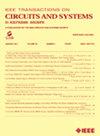DRAM Physically Unclonable Function (PUF) Using Dual Word-Line Activated Twin-Cells
IF 4
2区 工程技术
Q2 ENGINEERING, ELECTRICAL & ELECTRONIC
IEEE Transactions on Circuits and Systems II: Express Briefs
Pub Date : 2025-01-16
DOI:10.1109/TCSII.2025.3530514
引用次数: 0
Abstract
Physically unclonable function (PUF) generates a unique fingerprint or root of trust using the inherent randomness introduced during manufacturing. PUF outputs requires to be unique, random, robust, and unclonable. Dynamic random access memory (DRAM)-based PUFs are attractive due to their high density and randomness, achieved by controlling critical timings parameters, including使用双字行激活双电池的DRAM物理不可克隆功能(PUF)
物理不可克隆功能(PUF)利用制造过程中引入的固有随机性生成唯一的指纹或信任根。PUF输出需要是唯一的、随机的、健壮的和不可克隆的。基于动态随机存取存储器(DRAM)的puf由于其高密度和随机性而具有吸引力,通过控制关键时序参数(包括$t_{RCD}, $t_{RP}$和$t_{REF}$)来实现。传统的DRAM puf使用单个字线(WL)来选择连接到位线(BL)的单个单元,通过单元电容、漏电流和电荷再分配时序等属性的“绝对”不匹配产生随机输出。在本文中,我们提出了一种新的双细胞DRAM PUF,它采用了激活细胞之间的“差异”不匹配。该设计中的双wl激活了连接到BL和位线条(BLb)的双cell。通过接入晶体管的泄漏电流使预充电池放电,电池电容中的剩余电荷在放电周期后重新分布到BL电容中。感测放大器放大双单元间的相对不匹配以产生PUF输出。PUF采用28 nm互补金属氧化物半导体(CMOS)工艺制备。它在1v的标称电压下工作。在标称电压和温度下,均匀性为49.5%,可靠性为98.51%。芯片间汉明距离(HD)为45.91%,而wl间和puf间的HD分别为50.19%和49.98%。
本文章由计算机程序翻译,如有差异,请以英文原文为准。
求助全文
约1分钟内获得全文
求助全文
来源期刊
CiteScore
7.90
自引率
20.50%
发文量
883
审稿时长
3.0 months
期刊介绍:
TCAS II publishes brief papers in the field specified by the theory, analysis, design, and practical implementations of circuits, and the application of circuit techniques to systems and to signal processing. Included is the whole spectrum from basic scientific theory to industrial applications. The field of interest covered includes:
Circuits: Analog, Digital and Mixed Signal Circuits and Systems
Nonlinear Circuits and Systems, Integrated Sensors, MEMS and Systems on Chip, Nanoscale Circuits and Systems, Optoelectronic
Circuits and Systems, Power Electronics and Systems
Software for Analog-and-Logic Circuits and Systems
Control aspects of Circuits and Systems.

 求助内容:
求助内容: 应助结果提醒方式:
应助结果提醒方式:


